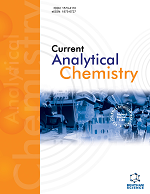- Home
- A-Z Publications
- Current Analytical Chemistry
- Previous Issues
- Volume 11, Issue 1, 2015
Current Analytical Chemistry - Volume 11, Issue 1, 2015
Volume 11, Issue 1, 2015
-
-
Recent Advances in Luminescent Carbon Dots
More LessAuthors: Osman Kargbo, Yan Jin and Shou-Nian DingSince the discovery of their benign (non-toxic) and excellent fluorescent properties, carbon dots (or C-dots) have attracted extensive attentions and presented a clear demonstration of great potential in bioanalytical applications. This intrinsic and somewhat exceptional nontoxic property of C-dots makes them potential alternatives to the conventional semiconductor quantum dots counterpart containing heavy metals that pose seri Read More
-
-
-
Photosensitizing Dye: Its Voltammetric Behavior and Determination in Cosmetics
More LessAuthors: Lai-Hao Wang and Shih-Ting ChenWe developed a method that uses electrochemical impedance spectroscopy (EIS) to choose an electrode to determine photosensitizing dye No. 201 (quaternium-73), a thiazolium derivative, in cosmetics. The method is based on nanoparticle metal oxide (tin, cerium, cobalt, iron, and nickel)-modified carbon paste electrodes. Using differential pulse voltammetry (DPV), we found that the electrocatalytic property of tin oxide w Read More
-
-
-
A Novel Iron(III)-Selective Membrane Potentiometric Sensor Based on 5-Chloro-3-[4-(trifluoromethoxy) phenylimino] Indolin-2-one
More LessAuthors: Ersin Demir, Barıs Kemer, Olcay Bekircan and Hassan Y. Aboul-EneinA novel polyvinyl chloride (PVC) membrane sensor that is highly selective to Fe3+ ions was prepared by using 5-chloro-3-[4-(trifluoromethoxy)phenylimino]indolin-2-one (CFMEPI) ionophore. The sensor exhibits a Nernstian response for Fe3+ ions over a wide concentration range (1.0 ×10-2 -1.0×10-6M) with a slope of 46.7±0.5 mV per decade. The sensor has a response time of 20s and can be used for at le Read More
-
-
-
Liquid Phase Extraction of Cd2+, Ni2+, Pb2+ and Zn2+ by N-benzoyl-nphenylhydroxylamine (BPA) from Environmental Waste Samples
More LessAn efficient liquid-liquid extraction method was developed for the removal of Cd2+, Ni2+, Pb2+, and Zn2+ from environmental waste using n-benzoyl-n-phenyl hydroxylamine (BPA). The effects of solvents, pH, stripping agents, extraction time, and interference of other ions on the recoveries were investigated. Study shows chloroform is the most efficient solvent for BPA and maximum extraction percentage of met Read More
-
-
-
Determination of Mercury in Iron Supplement Using Slurry Sampling and Cold Vapor Atomic Absorption Spectrometry
More LessThis paper proposes a method using slurry sampling and cold vapor atomic absorption spectrometry (CV AAS) for the determination of mercury in iron supplement used for the treatment of anemia. The optimization step of the slurry preparation was performed using a two-level full factorial design involving the experimental factors: hydrochloric acid concentration, thiourea concentration and sonication time, having as chem Read More
-
-
-
Detection of Phenolic Compounds by Tyrosinase Modified Clark Type Electrode
More LessAuthors: Margarita Stoytcheva, Roumen Zlatev, Mary Triny Beleno and Gisela MonteroIn this work is suggested a Clark type electrode with disposable enzyme membrane for phenols determination. This approach allows avoiding the electrode fouling by recording the oxygen reduction current, and obtaining a stable and reproducible sensor response. An appropriate method for enzyme membrane fabrication by cellulose acetate filters coating with tyrosinase through the use of biocompatible hydrogels was propo Read More
-
-
-
Ethanol Determination in Alcoholic Beverages Using Two Different Amperometric Enzyme Sensors
More LessAuthors: Riccardo Angeloni, Mauro Tomassetti, Mauro Castrucci and Luigi CampanellaTwo different enzyme electrodes for the determination of ethanol in alcoholic beverages were developed by immobilizing alcohol oxidase or catalase in a k-Carrageenan gel layer overlapping an amperometric gaseous diffusion Clark type oxygen electrode. The response of biosensors toward standard solutions of ethanol,methanol, n-propanol, n-butanol, ethylenglycol and glycerol was recorded, compared and discusse Read More
-
-
-
β-Cyclodextrin as the Mobile Phase Component for Separation of Some DNS-Amino Acid Enantiomers with HPTLC and PPEC
More LessAuthors: Beata Polak and Pawel GarbaczSeparation of 5-(dimethylamino) naphthalene-1-sulphonyl (DNS-) derivatives of some amino acids (alanine, leucine, valine, phenylalanine) D- and L-enantiomers with high-performance thin layer chromatography (HPTLC) and pressurized planar electrochromatography (PPEC) both with β-cyclodextrin as the component of the mobile phase is presented. The separation mechanism in the PPEC technique involves two effects Read More
-
Volumes & issues
-
Volume 21 (2025)
-
Volume 20 (2024)
-
Volume 19 (2023)
-
Volume 18 (2022)
-
Volume 17 (2021)
-
Volume 16 (2020)
-
Volume 15 (2019)
-
Volume 14 (2018)
-
Volume 13 (2017)
-
Volume 12 (2016)
-
Volume 11 (2015)
-
Volume 10 (2014)
-
Volume 9 (2013)
-
Volume 8 (2012)
-
Volume 7 (2011)
-
Volume 6 (2010)
-
Volume 5 (2009)
-
Volume 4 (2008)
-
Volume 3 (2007)
-
Volume 2 (2006)
-
Volume 1 (2005)
Most Read This Month
Article
content/journals/cac
Journal
10
5
false
en


